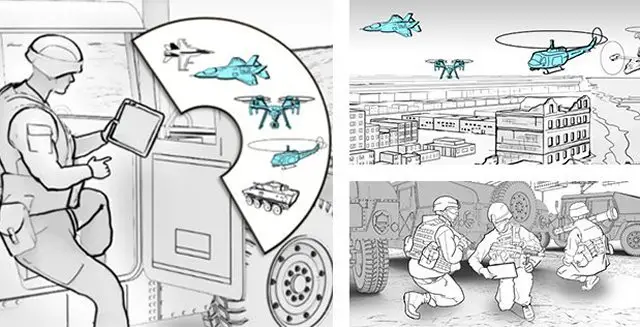The program will test the new tools and concepts in an integrated virtual environment, with the ultimate goal of developing fluidly composable force packages able to maximize tactical advantage in these complex, urban environments.
The program, dubbed Prototype Resilient Operations Testbed for Expeditionary Urban Scenarios (PROTEUS), seeks to deliver a software platform for use on a tablet or other personal device that would enable dynamic and adaptive composition of battlefield elements—including dismounted forces, vehicles, unmanned aerial vehicles (UAVs), manned aircraft, and other available assets—simultaneously across multiple command levels as the fight is evolving. The second focus area of the program is to develop an entirely new interactive virtual testbed, using novel mechanics built around multiscale decision making, to evaluate operational concepts spanning multiple domains, such as ground, sea, air, and electromagnetic spectrum.
DARPA on June 15 posted a Broad Agency Announcement describing the program in detail. A Proposers Day is scheduled for June 30 in Arlington, Virginia.
“The urban fight is about delivering precise effects and adapting faster than the adversary in an uncertain, increasingly complex environment,” said John Paschkewitz, DARPA program manager. “For U.S. forces to maintain a distinct advantage in urban coastal combat scenarios, we need agile, flexible task organizations able to create surprise and exploit advantages by combining effects across operational domains. Through PROTEUS, we aim to amplify the initiative and decision-making capabilities of NCOs and junior officers at the platoon and squad level as well as field-grade officers commanding expeditionary landing teams, for example, by giving them new tools to compose tailored force packages not just before the mission, but during the mission as it unfolds.”
The vision for the battle management/command and control (BMC2) software is to enable agile precision warfighting, so tactical operators can quickly design, compose, and recompose force packages on the fly to surprise the enemy.
“We aim to develop a tool to enable Marines to adapt their systems and tactics faster than the adversary,” Paschkewitz said. “The tool would show all available air, ground, sea, and spectrum assets in an area and determine how they could best be combined—whether that means, for example, delivering combined arms fire support for a Marine in need or providing transportation for that Marine to escape.”
In another example, a squad leader could use the tablet tool to coordinate combined reconnaissance support from several small UAVs organic to the unit, electronic warfare support from a long-endurance UAV like a Reaper in the vicinity, and combined arms fire support from a nearby attack helicopter and tank. As envisioned, the BMC2 tool would give the tactical operator real-time awareness of locally available assets and would share that view with higher command echelons, enabling the entire team to think “one step ahead.”
A second goal of PROTEUS is to create an interactive virtual testbed where new BMC2 tools and concepts can be integrated and tested at various levels of command, to demonstrate the agile composition of force packages.
“The idea for the interactive virtual testbed is to allow tactical and higher-echelon operators to explore and evaluate new tactics based on dynamic composition and then build ‘muscle memory’ by applying the most effective ones in an engaging virtual environment,” Paschkewitz said. “We’re not trying to develop a massively multi-player online game like many popular commercial games that already exist, nor is PROTEUS looking to mimic or advance existing DoD Live-Virtual-Constructive (LVC) software. Instead, we want developers to come up with innovative, decision-focused, virtual worlds that correctly capture the complex and non-linear consequences of choices made at both the command and tactical levels by both friendly and opposing forces. The urban fight has enormous uncertainty and the dimensionality of the battlespace is huge, which requires human judgment and decision-making that you can’t automate away. We’re looking for concepts with ease of use and demonstrable utility simulations similar to existing interactive tactical decision games used by U.S. forces, yet with greatly increased battlespace scale, complexity and detail.”



